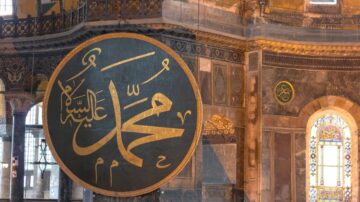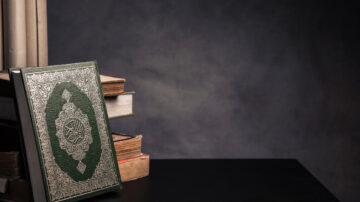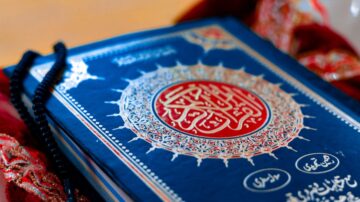The Quranic concept of adornment (Zinah) goes beyond external beauty—it is a profound spiritual and ethical framework that reshapes how believers perceive and engage with the idea of beauty. Building on Dr. Adel Al-Wadi’s research, this article explores the linguistic roots, theological insights, and practical applications of Zinah, showing how the Quran elevates adornment into a means of worship, reflection, and ethical living.
The Linguistic Core of Zinah
At its heart, the Arabic root of Zinah, (ز-ي-ن), signifies beauty and the act of beautification. It is the direct opposite of “Shayn” (شَيْن), which means ugliness or a flaw. This simple linguistic binary sets the stage for a more complex understanding.
The true depth is illuminated by the work of scholars like the 11th-century exegete Al-Raghib Al-Isfahani. In his influential dictionary of Quranic terms, he wasn’t content with a literal definition. He introduced a crucial philosophical division of Zinah:
- True Adornment (الزينة الحقيقية): This is an absolute, untarnished beauty that elevates a person in all circumstances, both in this life and the next. It has no downsides. For example, the wisdom a person possesses is a true adornment; it is beautiful in the eyes of the wise, beneficial in society, and a source of reward from God. Similarly, the humility of a leader or the patience of someone undergoing hardship are true, enduring adornments.
- False or Relative Adornment (الزينة الزائفة): This is a conditional beauty that may look appealing in one context but becomes a source of shame or harm in another. The most potent Quranic example is wealth. While lawful wealth used for good is an external adornment, wealth that is hoarded, gained illicitly, or causes arrogance becomes a “Shayn”—a spiritual ugliness—in the sight of God, even if it appears as a “Zayn” in the eyes of the world.
This framework is revolutionary because it shifts the metric of beauty from the purely aesthetic to the ethical and consequential.
Quranic Education: Meccan vs. Medinan Contexts
The statistical finding that two-thirds of the mentions of Zinah are in Meccan surahs is not a coincidence; it reveals a deliberate divine pedagogy.
1. The Meccan Phase: Building a Worldview of Beauty
In Mecca, the primary mission was to establish Tawhid (the Oneness of God) and correct foundational beliefs. The Quran used the concept of Zinah to achieve this by consistently linking beauty to its true source: Allah. The focus was on the macro level:
- Cosmic Adornment as a Sign (Ayah): The stunning beauty of the universe was presented not as a random occurrence, but as a deliberate act of adornment by the Creator, pointing to His power and artistry.“Indeed, We have adorned the nearest heaven with an adornment of stars.” (Quran 37:6) “And the earth – We spread it out and cast therein firmly set mountains and made grow therein [something] of every beautiful kind.” (Quran 50:7)
The goal here was to re-orient the human gaze. Instead of worshipping beautiful idols or being mesmerized by worldly power, the early Muslims were taught to see the entire cosmos as an exhibition of God’s majesty. This makes the appreciation of beauty an act of worship and reflection.
2. The Medinan Phase: Legislating for a Beautiful Society
In Medina, the Muslim community was established as a socio-political entity. Here, the verses on Zinah became more specific, focusing on legislation and social conduct. The aim was to translate the beautiful principles of faith into a beautiful, functioning society.
- Social and Personal Adornment: The most famous example is in Surah An-Nur (The Light), where guidelines are given for a woman’s adornment.“…and not to display their adornment except what [ordinarily] appears thereof and to wrap [a portion of] their headcovers over their chests and not to display their adornment except to their husbands, their fathers…” (Quran 24:31)
This legislation, revealed in the Medinan phase, is not about suppression but about sacralizing and protecting beauty. It frames a woman’s adornment within a secure and dignified context, preventing its commodification and preserving social harmony and modesty. This is a practical application of beauty, designed to build a virtuous and stable community.
Thematic Exploration: The Facets of Zinah
The Quran presents Zinah in several distinct thematic contexts, each offering a vital lesson.
- Zinah as a Test (Ibtila’): This is one of the most crucial themes. The Quran repeatedly frames the attractive things in this world—wealth, children, power, and luxury—as a temporary adornment designed to test our character.“Wealth and children are the adornment of the life of this world…” (Quran 18:46)The verse doesn’t condemn wealth or family. It contextualizes them. They are the “multiple choice options” of our life’s test. The real success is not in acquiring them, but in choosing the “best of deeds” while engaging with them. This prevents the believer from becoming enslaved by worldly beauty.
- The Ultimate Adornment: Enduring Good Deeds: In direct contrast to the fleeting Zinah of the world, the Quran offers the superior alternative: al-bāqiyāt al-ṣāliḥāt (the enduring good deeds).“…But the enduring good deeds are better with your Lord for reward and better for [one’s] hope.” (Quran 18:46)What are these deeds? Commentators explain they include prayers, remembrance of God (dhikr), charity, kindness, and every act of righteousness. They are “enduring” because their value transcends death, continuing to beautify a person’s record in the hereafter. This is the ultimate spiritual investment.
- The Inner Adornment of Faith (Iman): Perhaps the most beautiful form of Zinah is the one placed directly by God into the heart of a believer.“…but Allah has endeared to you the faith and has made it beautiful in your hearts…” (Quran 49:7)This verse implies that Iman (faith) itself is an internal aesthetic. It beautifies the soul, leading to tranquility (sakinah), noble character, and a luminous countenance. This is the source code for all other forms of true beauty.
Conclusion: The Quran’s Paradigm Shift on Beauty
The Quranic concept of Zinah, as illuminated by Dr. Al-Wadi’s study, is not merely about aesthetics; it is a complete ethical and spiritual paradigm. It teaches that beauty is not something to be merely possessed or displayed, but a responsibility and a pathway to knowing God. It shifts our focus from the perishable adornments of the world to the enduring beauty of righteous deeds and the internal adornment of faith. By understanding Zinah in its full Quranic depth, one learns to see the world not as a marketplace of fleeting attractions, but as a gallery of divine signs, where the ultimate goal is to become a reflection of that divine, enduring beauty.
By Dr. Adel Al-Wadi

















